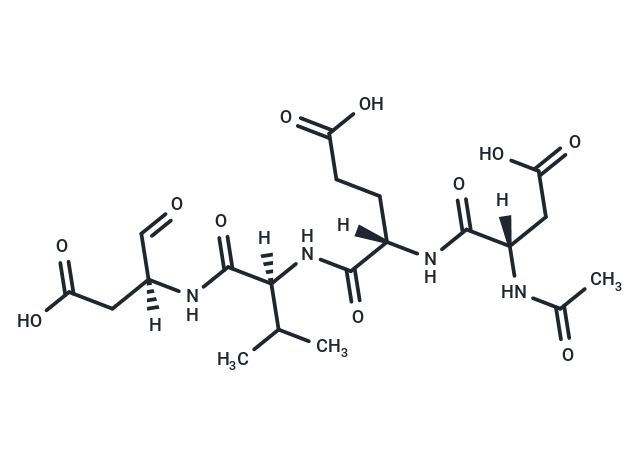Shopping Cart
- Remove All
 Your shopping cart is currently empty
Your shopping cart is currently empty

Ac-DEVD-CHO is a specific Caspase-3 inhibitor (Ki: 230 pM) with inhibitory effects on SLNT-induced apoptosis.

| Pack Size | Price | Availability | Quantity |
|---|---|---|---|
| 1 mg | $68 | In Stock | |
| 2 mg | $108 | In Stock | |
| 5 mg | $237 | In Stock | |
| 10 mg | $349 | In Stock | |
| 25 mg | $592 | In Stock | |
| 50 mg | $845 | In Stock |
| Description | Ac-DEVD-CHO is a specific Caspase-3 inhibitor (Ki: 230 pM) with inhibitory effects on SLNT-induced apoptosis. |
| Targets&IC50 | Caspase-10:12 nM (Ki), Caspase-3:0.23 nM(Ki), Caspase-8:0.92 nM(Ki), Caspase-7:1.6 nM(Ki), Caspase-1:18 nM(Ki) |
| In vitro | The addition of Ac-DEVD-CHO significantly prevents SLNT-induced apoptosis (from 32.91% decreases to 15.88% while NC and Ac-DEVD-CHO groups are 6.45%, and 7.77%, respectively) [2]. Ac-DEVD-CHO (10 μmol/L) partially blocks the effect of SIN-induced apoptosis and reduces the number of apoptotic nuclei. These effects of SIN are blocked by the caspase-3 inhibitor Ac-DEVD-CHO. Camptothecin (4 μM), a positive control, increases caspase-3 activity, which is also blocked by Ac-DEVD-CHO.[3] |
| In vivo | One hundred and two male C57BL/6 mice were subjected to cecal ligation and puncture (CLP, a model of polymicrobial sepsis) or sham operation. The animals were assigned into three equal groups (n=34) according to the random number table: sham group, model group, and caspase-3 inhibitor (CI) group. Thirty minutes before CLP, Ac-DEVD-CHO (4 μg/g) was injected subcutaneously in the CI group. The levels of blood urea nitrogen (BUN) and creatinine (Cr) were determined, and the concentrations of tumor necrosis factor-α (TNF-α), interleukins (IL-6 and IL-10) were measured by enzyme-linked immunosorbent assay (ELISA), the renal cell apoptosis rate was determined by flow cytometry and the expression of caspase-3 mRNA was determined by real-time reverse transcription-polymerase chain reaction (RT-PCR) at 6, 12 and 24 hours after operation. The 4-day and 7-day survival rates of three groups of mice were observed. Results: Compared with the sham group, the concentrations of serum BUN, TNF-α, IL-6, IL-10, and the renal cell apoptosis rates, the caspase-3 mRNA expression were increased significantly at all time points after CLP, the concentrations of serum Cr were increased significantly at 6 hours, with the 4-day and 7-day survival rates were decreased significantly. Compared with the model group, in the CI group, the concentrations of serum BUN were decreased significantly at all time points after operation and those of Cr were decreased significantly at 6 hours, then restored to those of the sham group at 12 hours and 24 hours; the concentrations of serum TNF-α, IL-6 were decreased and those of IL-10 elevated significantly at all time points. (P<0.05); the renal cell apoptosis rate and the expression of caspase-3 mRNA were decreased significantly at all time points. The 4-day survival rate of the CI group was improved (80% vs. 20%), but that of the 7-day did not change (20% vs. 20%).[4] |
| Molecular Weight | 502.47 |
| Formula | C20H30N4O11 |
| Cas No. | 169332-60-9 |
| Smiles | [H][C@@](CC(O)=O)(NC(=O)[C@@]([H])(NC(=O)[C@]([H])(CCC(O)=O)NC(=O)[C@]([H])(CC(O)=O)NC(C)=O)C(C)C)C=O |
| Relative Density. | 1.374 g/cm3 (Predicted) |
| Storage | keep away from moisture,store at low temperature | Powder: -20°C for 3 years | In solvent: -80°C for 1 year | Shipping with blue ice. | |||||||||||||||||||||||||||||||||||
| Solubility Information | H2O: 50.25 mg/mL (100.01 mM), Sonication is recommended. | |||||||||||||||||||||||||||||||||||
Solution Preparation Table | ||||||||||||||||||||||||||||||||||||
H2O
| ||||||||||||||||||||||||||||||||||||

Copyright © 2015-2025 TargetMol Chemicals Inc. All Rights Reserved.